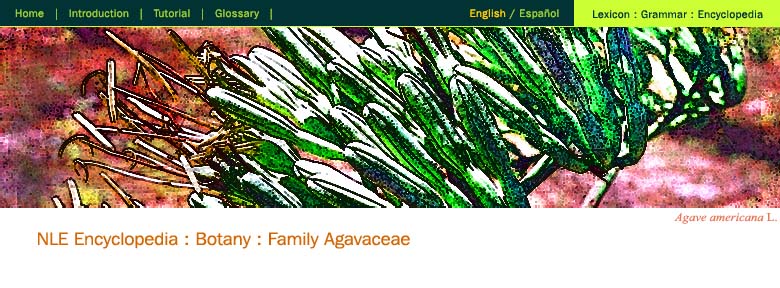

|
Agavaceae : The Agave, Century-Plant, or Yucca Family Agavaceae, a family closely related to the Liliaceae and Amaryllidaceae, are found in the form of trees, shrubs, or herbaceous plants, all of which are xerophytic (adapted to very dry conditions). Agavaceae are rhizomatous plants (as a mode of vegetative reproduction they have horizontal underground stems that root at the nodes) and monocots (having one seed leaf). The vegetative parts of Agavaceae continue growth until after flowering. Agavaceae experience a secondary thickening of the stem via a special cambium arising from the parenchyma (soft tissue cells with unthickened walls) outside of the vascular bundles. Leaves grow in rosette form that may begin at the base of the plant or from the ends of branches, with leaves crowded at base and thinning in appearance upward along the branch. Leaves are succulent and thick, often fleshy, fibrous, heavy, and hard; they are persistent in that they often remain on the plant for several years. Simple leaves vary in form from lanceolate to extremely wide and concave. They are also sometimes bayonet in shape and can be up to 3 meters long, lacking stipules. The margins and apex of the leaves are generally thorny, with leaf veins unapparent. Perfect flowers form terminal or clustered panicles (a branched raceme). They do not bloom annually. The perianth (sepals and petals) form a short to long tube with 6 lobes having an inferior (in the Agave genus) or superior (in the Yucca genus) 3-fused carpel ovary, a single and slender style, and 6 stamens located at base of the perianth tube. Flowers are fragrant; petals are thick and fleshy and of a greenish, white, or yellow color. They are generally actinomorphic (radially symmetrical with more than one plane of symmetry) or slightly zygomorphic (one plane of symmetry). The fruit of Agavaceae can form an indehiscent (not opening at maturity), dry or fleshy and spongy capsule, or a berry that is sometimes winged. Plant regeneration is generally via vegetative reproduction. The Agavaceae family comprises some 18 genera and 500 species that can be extremely variable in structure. The main genera are Agave (300 species) and Yucca (40 species). Plants of the Agavaceae family are most often native to tropical and subtropical regions, but adapt well to a variety of climates, especially those that are arid or semiarid. They are of great economic importance in Mexico and other regions of the Americas and provide food, fiber, tools, soaps, and medicine, particularly for indigenous peoples through North and Central America. Today the leaves of the Agave tequilana, A. pacifica, and A. palmeri continue to be cultivated for their juice. Alcoholic beverages, such as tequila and mescal, are made from fermented stems and heads that are cooked and mashed. A beverage known as pulque can be produced from the fermented sap of A. atrovirens. Roasted hearts of agave plants provide a food rich in sugar. Agave sisalana, whose leaves lack spines, is used to produce a strong fibrous material known as sisal, which can be made into rope, as well as into rugs, bags, and baskets. Some Agavaceae members also have ornamental importance, which has led to extensive planting of various species throughout adaptable climates. The Agave americana, or century-plant, can grow up to 7 meters tall and flowers after 15 to 20 years of growth, dying soon after seed formation. Additional important species include trees of the Cordyline, Dasylirion, and Nolina genera, grown for ornamental purposes, and of the genus Dracaena, which provides a resin used in producing varnishes and paints. Members of the genus Agave contain steroidal saponins that are used medicinally in the commercial production of steroids. Agavaceae can be found throughout Asia, Southeast Asia, Australia, and Polynesia, as well as West Africa. They are common in southern United States, Mexico, Guatemala, and the Caribbean. To date five species of this family have been collected in the Oapan, San Juan Tetelcingo, and Ameyaltepec area, belonging to the genera Agave (3 species) and Alloe (1 species). There is also one additional plant (called in Oapan mexkaltompistli de wé:weyák í:matlápal) not yet identified, but which has tentatively been classified as an Agavaceae (though it may turn out to be a member of the Bromeliaceae family). The following members of this family have been documented in sources
consulted on Guerrero flora: Agave angustifolia, Agave atrovirens,
Agave cupreata, Agave donnell-smithii, Agave kirchneriana, Agave mescal,
Agave tequilana, Beaucarnea sp., Beaucarnea hiriarteae, Manfreda brachystachys,
and Manfreda singuliflora. |
List of Agavaceae species collected, with most common Nahuatl names
|
Genus species
|
Ameyaltepec
|
S. Agustín Oapan
|
S. Juan Tetelcingo
|
||
| Agave americana L. | (not named) | kokohtitlantsi:n | kokontitlantsi:n | ||
| Agave aff. angustiarum Tret. | (not named) | ka:ka:lo:te:ntli / kwahli mexkahli | mexkahli de ka:ka:lo:te:ntli | ||
| Agave angustifolia Haw. | sakamexkahli / kukuwtitlantsi:n | sakamexkahli | kuhtitlantsi:n | ||
| Alloe aff. vera | ka:xti:hla:n mexkahli | ka:xti:hla:n mexkahli | chichi:k mexkahle |
List of Agavaceae species collected that have not yet been identified in the Western taxonomic system
|
Genus species
|
Ameyaltepec
|
S. Agustín Oapan
|
S. Juan Tetelcingo
|
||
| (not yet identified) | (not named) | mexkaltompistli de wé:weyák í:matlápal | (not named) |